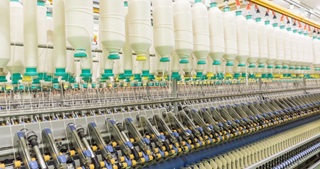Benefits of LPG for Textile Industry

The Indian textile industry, a cornerstone of many economies, is constantly seeking ways to improve its processes. The energy source for various processes makes a significant difference in achieving high-quality fabrics. The solution lies in the adoption of Liquified Petroleum Gas (LPG) as a primary fuel source. Let's explore how LPG can revolutionize textile manufacturing processes and elevate fabric quality.
LPG is a clean burning fuel, which provides precise heat, controlled flame, and efficient steam generation for various applications like singeing, drying, dyeing and calendering.
LPG ensures high fabric quality in the textile industry through several key mechanisms:
Combustion Efficiency:
LPG combustion provides a steady and reliable heat source. This consistency is crucial for various processes like drying, calendering, and heat setting. Modern burners and control systems, powered by LPG, allow for precise temperature regulation. This minimizes the risk of overheating or underheating, which can lead to fabric damage, colour fading, or dimensional instability.
Cleaner Combustion:
LPG combusts with a high
efficiency, producing a clean flame with minimal residues, soot and particulate
matter. This reduces contamination and which the purity and structural integration
of the fabric.
Also, lower emissions contribute
to a cleaner working environment, improving the health and safety of workers.
Thermal Processing:
In textile processes, maintaining
the correct temperature is vital for proper dye absorption and fixation. LPG
enables precise regulation of heat, ensuring that dyes penetrate the fabric
evenly and fix properly, resulting in vibrant and consistent colours.
For synthetic fibers like polyester, heat-setting is crucial for stabilizing dimensions and textures. LPG provides the necessary heat, enabling the fibers to undergo the required thermomechanical changes without scorching or weakening, thus enhancing durability and appearance.
Uniform Heat Distribution:
LPG-fuelled dryers can maintain even temperature distribution within drying chambers, ensuring that all areas of the fabric receive consistent heat. This prevents issues like warping, shrinking, or spots of uneven moisture, which can affect fabric quality.
The high calorific value of LPG allows for rapid heating, making the drying process quicker and more efficient. LPG-powered calendars deliver consistent heat and pressure, enabling the creation of specific finishes like gloss, sheen, and texture.
Compatibility with Modern
Equipment:
Modern LPG burners used in
textile machinery are designed for optimal performance and efficiency. They can
be fine-tuned to meet specific thermal requirements of different textile
processes, from pre-treatment and dye fixation to finishing and drying.
LPG systems can be integrated with automated control systems used in textile plants. This automation allows for real-time monitoring and precise adjustments to fuel flow, temperature, and processing times, ensuring consistent high-quality output.
LPG emerged as a superior fuel choice for various industries and applications, offering numerous advantages over traditional fuels. To ensure optimal performance and quality, consider partnering with SUPERGAS, a leading provider of high-quality SR-Grade LPG. Their commitment to delivering superior products and exceptional service can help you achieve impeccable prints and patterns with vibrant colours.
If you wish to know more, check out the case study of a customer who benefited from SUPERGAS.
We offer customised solutions to meet the unique needs of the textile industry. Contact SUPERGAS today at 9121177930 and experience the benefits of clean, efficient, and reliable LPG.